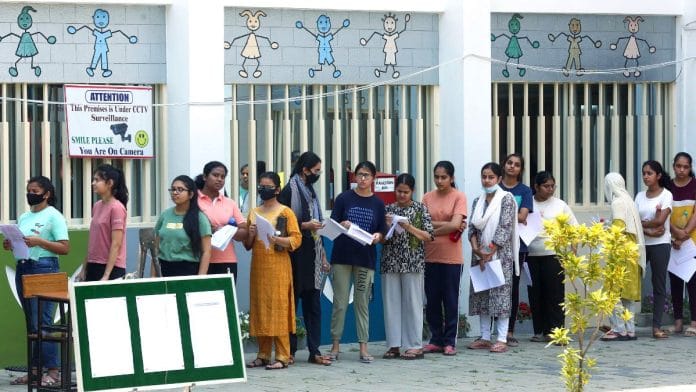Competitive exams such as JEE and NEET were meant to build careers but sadly, these exams have become a major cause of stress, anxiety, and other mental health-related issues among a large number of young Indians. The events unfolding around the NEET 2024 controversy have only added to this problem. Lakhs of students who aspire to pursue a course in medicine are now uncertain about their future.
As if this wasn’t enough, the delay in declaring the Common University Entrance Test (CUET) exam results has also triggered anxiety.
A large number of students, as young as 14-15 years old, start preparing for these highly competitive and difficult exams. Some students face pressure from their families to excel and get admission to the top technical and medical colleges and universities. These young students fear they may disappoint their parents if they are not successful. Many join coaching institutes, which, although they provide teaching, unfortunately, create a stressful environment with long study hours. The students are stressed even to secure top ranks in the internal exams of coaching institutes as if it will guarantee them a seat in a prestigious college.
Alarming suicide rates
Findings of a 2023 study conducted by the Lokniti-CSDS in Kota indicate that more than 85 per cent of students spend six to seven hours every day in coaching classes, and some even stretch it to eight hours. More than 80 per cent of students want at least one day off for leisure activities to relieve the burden of studying. Some students confirmed experiencing an increase in feelings of loneliness, mood swings, fatigue, anger, sadness, and depression since they moved to Kota. A large percentage of students started sleeping late at night than usual. As a result, they develop poor sleeping patterns, which has an impact on their mental health.
India is the world’s suicide capital with over 2.6 lakh cases in a year. According to the World Health Organization, the average suicide rate in India is 10.9 per lakh population. Tragically, one of the highest youth suicide rates is reported in India. The National Crime Records Bureau (NCRB) data states that one student took their own life every 42 minutes in 2020, meaning an average of 34 student suicides per day.
In the same year, 11,396 suicides of students below the age of 18 were reported across India. About 13,000 students died by suicide in 2021, which accounts for more than 35 suicides every day, a rise of 4.5 per cent from the 12,526 deaths in 2020, with 864 out of 10,732 attributed to “failure in examination”, according to the data as per NCRB’s Accidental Death and Suicide in India report 2021
The suicide rate is increasing among students at an alarming rate. Over 13,000 students died in 2022, according to the latest report on Accidental deaths and suicides data released by the NCRB. Students accounted for 7.6 per cent of all suicide deaths that year. The report also revealed that the highest percentage of deaths was seen among people with secondary-level education, which amounted to 23.9 per cent of all the suicides.
Seven students, allegedly died by suicide hours after the Telangana State Board released the results of the Intermediate Public Examination 2024. In 2019, 22 students took their own lives in the state after the intermediate results were released. As per the Ministry of Education, 122 students from IITs, NITs, central universities, and other central institutions died by suicide between 2014 to 2021. The increasing rate of suicide among students studying in Kota has become a matter of concern for governments, parents, and students.
Several measures have been taken by the government to prevent children from slipping into depression. One important step is arranging students into sections alphabetically instead of by rank. It helps reduce unhealthy competition and stress among young people.
Also Read: I attempted UGC-NET thrice—Now, I understand why students look abroad for PhD
Mental health crisis
Despite the disturbing consequences, addressing the issue of mental health and related disorders is a challenging task in India. The social stigma associated with these issues complicates the situation. The prejudice about consulting with a psychiatrist or a counsellor is what leads to delays in addressing anxiety and depression.
Moreover, there is a lack of good mental health professionals and services in the country, with only 0.3 psychiatrists, 0.07 psychologists, and 0.07 social workers per 1,00,000 people. In comparison, developed countries have 6.6 psychiatrists per 1,00,000 people. The global average number of mental hospitals is 0.04 per 1,00,000 people, while in India, it’s only 0.004. Removing the social stigma associated with mental disorders and seeking help, along with increasing the number of mental health professionals, can lead to effective treatment
Parents and teachers should keep a check on the behavioural changes among children and engage in conversations with them to understand their problems. We need to make sure that no child feels so helpless that they are forced to take the extreme step of taking their own lives.
Additionally, children should be encouraged to cultivate a hobby such as singing, dancing, painting, writing, reading, cooking, etc. It can help them de-stress. It’s important to develop efficient coping mechanisms to deal with the pressure of competing in exams. One should remember that they are not alone, they can always seek help from their loved ones and suicide is not the solution.
Manavi Nandini has passed her class 12 exam from Bal Bharati Public School, Brij Vihar, currently looking for career options. Sanjay Kumar is a professor at the Centre for the Study of Developing Societies (CSDS) in Delhi. Views are personal.
(Edited by Ratan Priya)







Is it possible that these snowflake kids don’t have it in them?
It would be an eye opener to see if reservations are pushing these kids to end their lives. Pretty sure the data was accessible to the authors.
Stop producing kids in India. Problem solved.